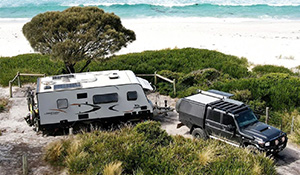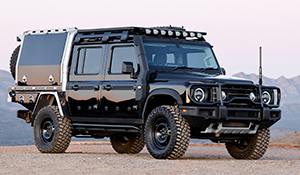ROAD TEST – 2016 Toyota FJ Cruiser
While we’d never argue with paying tribute to the heroic FJ40, the Tonka Truck version sold here as the ‘FJ Cruiser’ was never going to be a strong sales prospect for the Australian market without a diesel.
Origin of the Species
Teased in a series of concepts dating back to 1999, the FJ Cruiser became a reality for the 2006 model year, driven largely by North American and Middle Eastern market demand. The chunky looks and retro (ie. classic FJ Series from the 1950s) styling made the FJ Cruiser a popular vehicle in those markets, which led to it being offered in Australia from 2011.
Last May, just on five years after it was introduced locally, Toyota announced that FJ Cruiser production would come to an end in August, drawing the curtain on one of the quirkiest SUVs that the powerhouse Japanese brand has ever produced.
Toyota has sold just over 11,000 FJ Cruisers here, and you can expect a handful more on top of that as the last units disappear from local dealerships. But given Toyota sold 9,000 LandCruiser wagons (at more than twice the price in many instances) in Australia last year alone, the FJ Cruiser was always a niche product.
With this unmistakable SUV about to disappear from new car showrooms forever, it was an opportune time to take an FJ for one last drive.

Party for Five
The FJ Cruiser finally made it to right hand drive markets five years after its inception, running the four-litre V6 petrol powerplant and a little 72-litre fuel tank when it first arrived in Australia. While the tank expanded (in 2013), the petrol engine remained.
Essentially a short wheelbase petrol V6 Prado in a chunkier, sandpit toy set of panels, the FJ Cruiser is priced from $46,990 (just under the entry-level Fortuner in Toyota’s SUV lineup) and offers seating for five, although rear occupants get the novelty of climbing up (no mean feat either) into a somewhat snug backseat via forward-opening half-doors without any moving glass; standard side-steps was on the wishlist for those in the rear.
Up front, the driver gets height adjustable seating which, to a small extent, offsets tilt-only adjustment for the leather-wrapped steering wheel, as well as a dash-top multi-information display with temperature, compass and inclinometer, but no trip computer, and clear traditional instrument dials.

Old Looks, New Tech
Retro styling doesn’t - thankfully - lead to a dearth of safety gear in the FJ; there are active front head restraints, six airbags, stability control, anti-lock brakes, rear parking sensors and a reversing camera displaying on the auto-dimming centre mirror, which is better than nothing. But against modern LEDs, there are only halogen headlights in the FJ Cruiser.
The features list also includes touchscreen-controlled satnav, Bluetooth and USB connections, rear fog lights, tinted ‘privacy’ glass, cruise control, manual air-conditioning, front and handy side sun visors for the front occupants, helm-mounted audio controls, cloth trim, front and rear (in a fold-down armrest) cupholders, an eight-speaker sound system and central locking.
The three-quarter and straight rear vision is restricted by the spare mounted on the sometimes-fiddly tailgate and the absence of switchgear illumination for some features stymied the unfamiliar operator.

Thirsty, Sturdy
The solid off-roader is propelled by the four-litre petrol engine with the five-speed automatic transmission also seen in the Prado. The alloy V6 has 24 valves, variable valve timing and double overhead cams to deliver 200kW at 5600rpm and 380Nm at 4400rpm.
It’s enough to get the FJ Cruiser to 100km/h in around 8 seconds; cruising at that speed is a relaxed affair with 2000rpm on the tacho, but if rapid departures are part of the driver’s daily routine, or there’s a lot of off-road work in the schedule, the petrol pump will be taking plenty of your cash.
The ADR fuel economy claim on the combined run is 11.4 litres per 100km, rising to 15 on the urban test and 9.3 on the extra-urban cycle, but it does have a taste for 95RON PULP, which is not only a little pricier but is even more difficult to get in the bush - another point scored for diesel.
The FJ we drove drank at a rate of 14.7 litres per 100km in our time in the real world, but the fuel capacity expansion from 72 to 159 litres at least gives it a decent 1000km ballpark range.
Seventeen-inch alloy wheels (with a full-size spare) are controlled by independent double wishbone front and multi-link rear suspension systems which have large diameter dampers, coil springs and anti-roll bars tuned to a local calibration.
The locals also had a fiddle with the power steering tune; the result being a good ride quality without completely ignoring cornering prowess.

Capability ’Cruiser
The FJ Cruiser runs a part-time RWD/4WD system - there’s no on-road 4WD open centre diff option, something Mitsubishi offers in most of the Pajero and Triton and it makes foul-weather driving a more secure pastime.
Fast dirt is dealt with best in 4WD if the driver has no interest in self-entertainment; leaving it in RWD and turning off the electronics is a more amusing and attention-grabbing, if less sociable, way from A to B on an unsealed road.
As the off road terrain comes more challenging, there’s a rear differential lock and Toyota’s Active Traction Control, which uses the four-wheel ventilated disc brakes to control wheel spin in low range 4WD.
Also in the electronic arsenal is the so-called CRAWL system; an off-road cruise-control that in low range controls engine and brakes over severe or slippery terrain, in operation below 25km/h in low range - or 10km/h when the rear differential is locked.
The speed is controlled by a five-step speed dial in the overhead console and the system does as the maker intended, although it is prone to lurching and shunting when it is asked to work hard.
Off-road work showed the 224mm of ground clearance is enough (although a little more would be desirable), backed by robust underbody protection.
The electronic aids for the driver are not subtle, but for the most part are a welcome back-up to the Dunlop Grandtrek factory-fitted rubber. On test, these compromise tyres were overcome by a rutted and muddy incline, but the FJ’s 4WD systems made short work of most challenges, clambering over plenty of obstacles prior to the steep mud climb.

Big Bird
The FJ Cruiser is 4670mm long (with a 2690mm wheelbase), 1905mm wide and 1830mm tall, but thanks to short overhangs, it has useful approach and departure angles - 36 degrees at the front and 31 degrees at the rear, with a 29-degree ramp-over angle.
Kerb weight is exactly two tonnes, but the braked towing capacity of 2250kg isn’t class-leading, not surprising given the Prado hasn’t improved much recently, either.
In addition to the suspension and steering calibration, local testing resulted in changes to the insulation package, too, countering our coarse-chip roads. The cruising speed refinement and low wind and engine noise are testimony to a job well done in this area.
Sad Farewell
While its departure won’t have a profound impact on Toyota’s sales tally, it is sad to see the FJ experiment end, as it was an example of heart overruling head when it comes to vehicle production.
But without a diesel, it was never going to make a serious impact on the Australian 4WD market. That being said, a new Prado turbo-diesel engine in the rounded retro snout of an FJ Cruiser would be a worthy experiment. Anyone out there already tried it or are willing to?

2016 Toyota FJ Cruiser
ENGINE: 4.0lt DOHC dual VVTi petrol V6
MAX POWER: 200kW @ 5,600rpm
MAX TORQUE: 380Nm @ 4,400rpm
TRANSMISSION: 5-speed automatic w/lock-up torque converter
DRIVE: Part-time 4WD w/2-speed transfer case
CONSUMPTION – COMBINED CYCLE: 11.4lt/100km
FRONT SUSPENSION: Independent double wishbone w/coil springs, gas dampers and stabiliser bar
REAR SUSPENSION: Independent five-link w/coil springs, gas dampers and stabiliser bar
STEERING: Hydraulic R&P w/power assist
WHEELS: 17-inch Fr/Rr
TYRES: 265/70 R17
SPARE WHEEL: Full Size
BRAKES: Ventilated disc Fr/Rr w/ABS, EBD and Brake Assist
SEATING CAPACITY: 5
LxWxH: 4670mm x 1905mm x 1830mm
WHEELBASE: 2690mm
GROUND CLEARANCE: 224mm
WADING DEPTH: 700mm
APPROACH/DEPARTURE/BREAKOVER ANGLE: 36/31/29 degrees
FUEL CAPACITY: 159lt (72lt main + 87lt sub post-2012)
KERB WEIGHT: 1955 - 2000kg
CARGO CAPACITY: 990lt max
TOW CAPACITY: 2250kg braked
GVM: 2510kg
SAFETY RATING: N/A
PRICE: $46,990 + ORCs
WARRANTY: 3yr/100,000km
<a href="www.toyota.com.au">toyota.com.au</a>




























